L's Garden Checkpoint 3 -- 4 weeks later
Here we are, 1 month after we started logging L's garden progress, closer to 6 weeks since L started up her gardening efforts.
The Confederate Jasmine (Trachelospermum Jasminoides) hasn't been growing very quickly, but there is visible progress.

Garden checkpoint 3: Confederate Jasmine growth
L's bug-eaten basil is still hanging on there; it is currently flowering -- maybe she'll have basil plants sprout up in her lawn.
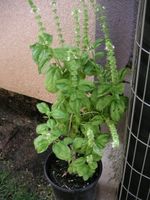
Garden checkpoint 3: old flowering basil
While L transplanted her eggplant and sweet Genovese basil seedlings weeks ago, she left the oregano seedlings in its first container. It hasn't grown much, but L says it hasn't been getting much sun. L will transplant it within the next few days.

Garden checkpoint 3: oregano seedlings still small
Finally, L's gardenia radicans is blooming. I was afraid hers would remain just green foliage; it's nice, but the flowers are nicer. It looks like more flowers will blossom soon.
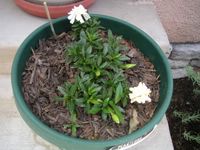
Garden checkpoint 3: Gardenia Radicans, w/ unopened flower buds
L is slowly taking over other little dirt plots bordering her property. Here she planted some yellow zinnias.
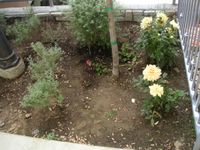
Garden checkpoint 3: yellow zinnias
I'm a sucker for fragrant plants, and so is L. She recently bought more gardenias from the San Gabriel Nursery. This new gardenia is gardenia vetchii (previously they were gardenia 'mystery'). Her gardenias seem to be doing okay, even though I've heard gardenias can sometimes be tricky flowers to grow.
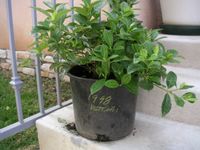
Garden checkpoint 3: Gardenia Vetchii, to be planted into the ground
Now we come to the new bamboo plants I bought by phone from the Bamboo Garden Nursery. I purchased different "black" bamboo, all Phyllostachys Nigra. For healthy bamboo in 1 gallon pots, the varieties I got were fairly cheap, ranging from $15-$20 each.
Phyllostachys Nigra - Bory is also known as the leopard or snakeskin bamboo, since grows to have mottled green/brown/beige culms.
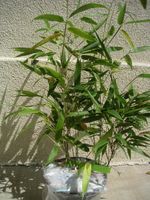
Garden checkpoint 3: Phyllostachys Nigra (Bory), still in container
Phyllostachys Nigra - Hale is like the normal Phyllostachys Nigra, but some people have reported its culms turning blacker faster than the normal Phyllostachys Nigra. Phyllostachys Nigra culms grow out green, then in a year or so turn black.
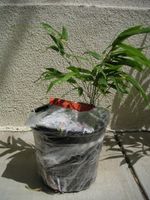
Garden checkpoint 3: Phyllostachys Nigra (Hale), still in container
The leaves remain a vivid green, so I think the contrast of green leaves on black culms would look nice. L's hubby doesn't think so -- he prefers the green culms or green with yellow striped culms. Snob!

Garden checkpoint 3: Phyllostachys Nigra, still in container
L's idea of thriving is not mine. The plumeria below is in E's front plot, where only a few leaves have unfurled and grown larger. I think this means the plumeria hasn't fully rooted yet, but we'll see.
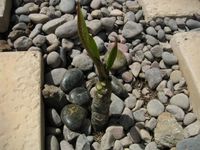
Garden checkpoint 3: Plumeria, E's front yard,starting to root
L filled in E's front plot with rocks and heavy tiles. Hopefully it will cut down on weeds and unwanted volunteers. It's also more comfortable to walk on when we go near the external faucet.
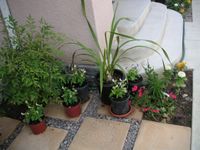
Garden checkpoint 3: E's front plot, left facing front door
Finally L's stubborn little Jasmine Sambac (Arabian Jasmine, popcorn jasmine) started blooming. It has a pretty heady scent. This is the jasmine that is used in some Chinese teas.
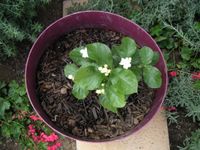
Garden checkpoint 3: Jasmine Sambac finally blooming
L added in a some cheaper $6-$9 gardenias from the San Gabriel Nursery to E's front plot (right). They currently aren't blooming, but will soon.
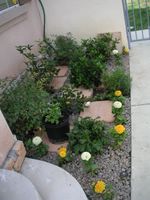
Garden checkpoint 3: E's front plot, right facing front door
How sad. Here's E's dead 白玉蘭. The grass around it is yellow/dead because E and company didn't discover the second set of sprinklers was not turned on until the the grass yellowed. They have since rectified the mistake, but it will be a while before the lawn turns green.

Garden checkpoint 3: ?Dead? Michelia x. Alba in E's backyard garden
Here's a boring look at E's patio. It doesn't seem to have changed much, but more plants are in bloom, and L's guava trees have since recovered from their transplant shock/fertilizer burn. L's guava trees have few fruits as a result of the transplanting, but at least healthy new foliage is growing in.

Garden checkpoint 3: Facing E's patio
This is the second plumeria that we believe to be halfway through the rooting process. Again, I don't see how L can call this "thriving." I hope it fully roots in time for the evil first winter dormancy period.
Garden checkpoint 3: Facing patio in E's backyard

Garden checkpoint 3: Newly rooted plumeria in E's backyard
Here's the longyan tree L got from Black Pearl Nursery > 1 month ago. It's trunk still seems pretty weak, but the foliage shows how the tree has since recovered from its transplant shock.
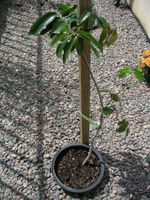
Garden checkpoint 3: Recovered Longyan Tree
I'm especially amazed at how the loquat tree I bought on Ebay from some guy in a southern state has recovered. It had been shipped bareroot, and practially all the leaves were edged in brown. You can still see some of the old leaves toward the bottom of the plant, and on the rocks. All the upper healthy leaves are new growth.
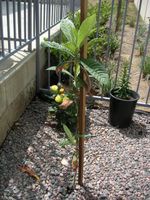
Garden checkpoint 3: Recovered Loquat Tree
L's pepper tree that she got as a starter plant from her dad has been yielding tiny ripened red peppers lately, a few each day. I once made the mistake of popping one of the smaller ones in my mouth -- not very bright of me. L said at her old place, an adventurous bird once did that and then spit it out half-eaten.
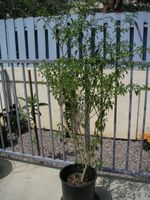
Garden checkpoint 3: L's pepper tree on cement patio, now with ripened red peppers
The passiflora edulis is still slowly but surely growing. The growth isn't as spectacular as before, but it's probably reached the limit of its 10+ gallon container. There are numerous flowers going into bloom, but still only 1 tiny little fruit hiding behind the fence.
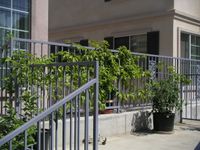
Garden checkpoint 3: Slanted view of Passiflora Edulis growing on ledge
Yay! While we have some aphid and thrips in the garden, it seems we've attracted a few good bugs. In the picture below we have a ladybug perched near the nectaries of the passiflora edulis vine. Here's hoping that she has a lot of babies!
Garden checkpoint 3: View of passiflora edulis
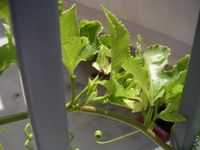
Garden checkpoint 3: Ladybug nestling amid passiflora edulis leaves
Onto L's tomato progress. The Russian Black Seaman tomato plant has the healthiest foliage (no wizened branches or brown leaves).

Garden checkpoint 3: Black Seaman heirloom tomato (Russian variety)
But this black heirloom tomato has only 1 tiny tomato growing in and only a handful of yellow tomato blossoms. Ah well, hopefully the few fruits will be excellent. I'm a little puzzled b/c I've read online that Black Seaman is potato leafed (PL), but this plant that was labeled Black Seaman appears have regular tomato leaves (RL).
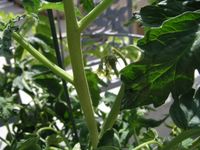
Garden checkpoint 3: Black Seaman -- sole fruit
Wow. L said she didn't notice any fruits growing in on the Italian Principe Borghese plant until one day, wham!
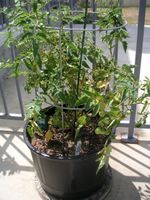
Garden checkpoint 3: Principe Borghese heirloom tomato (Italian)
Check out the fruits on this baby. The Italian Principe Borghese plum tomatoes are growing in crazy fast. It may not be obvious, but there are > 60 tomatoes currently on the plant. The tomatoes will grow into 1"-2" tomatoes that are good for drying.
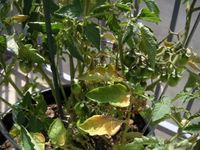
Garden checkpoint 3: Principe Borghese, loaded with fruit (60+)
Omar's Lebanese is supposed to be the plant that yields large tomatoes. The foliage is pretty healthy, though not as great as the Black Seaman tomato's.

Garden checkpoint 3: Omar's Lebanese heirloom tomato
There are only about 6 tomatoes currently growing on the plant, but I don't expect that many tomatoes since this plant is growing in a container.

Garden checkpoint 3: Omar's Lebanese, a few larger fruit growing in
Next up are the transplanted Sweet Genovese Basil (Italian) and Pingtung Eggplant (Taiwanese) plants. They are growing nicely, but I checked out the leaves and noticed some "sucking" damage. The larger of the basil plants has holes eaten through. What is it about basil leaves that attracts bugs like crazy?

Garden checkpoint 3: 2 Sweet Genovese Basil plants, 2 Pingtung Eggplant plants (Taiwan)
The French Carmello tomato plant is growing well, but with only a handful of tomatoes. I'm not so concerned of the lack of tomatoes since the Carmello plant is able to produce tomatoes in colder weather than most plants.
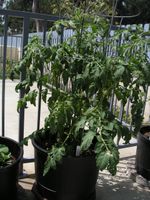
Garden checkpoint 3: Carmello heirloom tomato (French variety)
Carmello should produce medium-sized round red tomatoes.
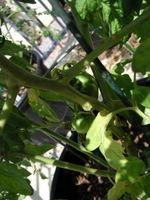
Garden checkpoint 3: Carmello, very few fruits
After some fiercely hot and sunny weather, the Sweet Millions hybrid cherry tomato plant had a lot of leaves and steams dry up and wither. I removed a lot of that dead growth, which is why the lower half of the plant seems to be very bare.

Garden checkpoint 3: Sweet Millions hybrid tomato
I sincerely hope the remaining foliage is enough to support the current fruits. There are about 40+ cherry tomatoes on the plant right now.
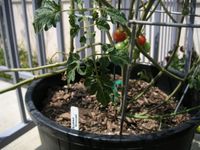
Garden checkpoint 3: Sweet Millions, a few ripened fruit
Since the last garden checkpoint, the Aunt Ruby's German Green heirloom tomato plant looked as if it were on its last legs. It had lost a lot of leaves and was turning a lighter green.
Now it looks better, but still too small. Its growth seems to have been put back by a month. I'm not certain it will be able to fruit before the October cold/rain begins, but we'll see.

Garden checkpoint 3: Aunt Ruby's German Green heirloom tomato, recovering but still small
I thought I'd take a picture of E's indoor spider plant. E received this as a housewarming gift. E didn't realize the smaller growths were baby spider plants, known as spider pups.

Garden checkpoint 3: E's indoor spider plant, mother and pups
E gave me his blessing and allowed me to remove the pups. I'm going to bring them back to UCSB, maybe one to stick in my room, another to stick in lab.

Garden checkpoint 3: Closeup of spider pups


0 Comments:
Post a Comment
<< Home